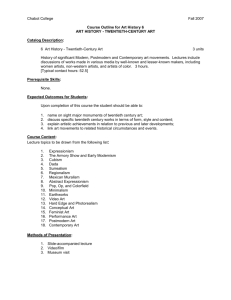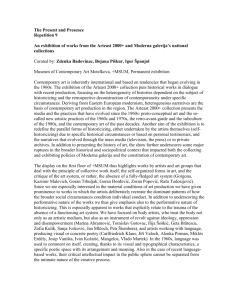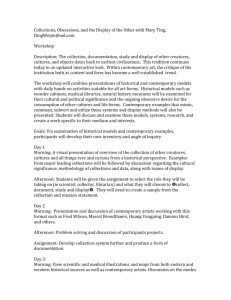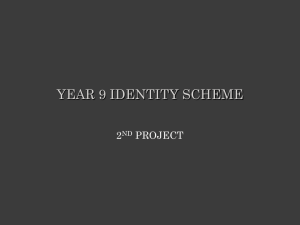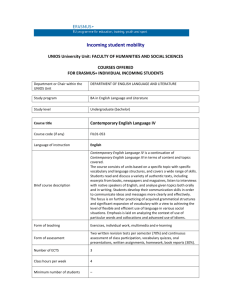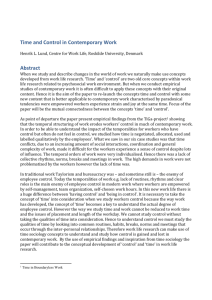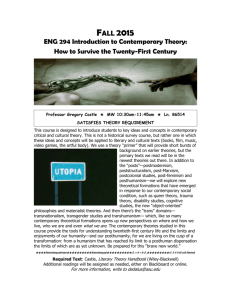Word format - Arts Council England
advertisement
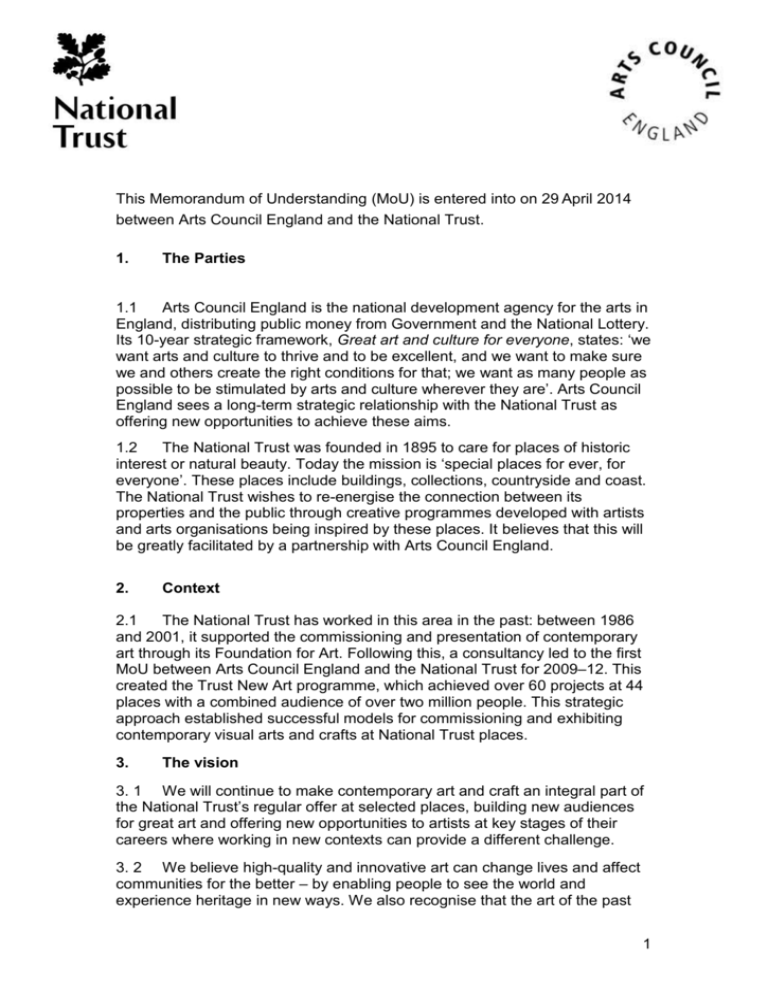
This Memorandum of Understanding (MoU) is entered into on 29 April 2014 between Arts Council England and the National Trust. 1. The Parties 1.1 Arts Council England is the national development agency for the arts in England, distributing public money from Government and the National Lottery. Its 10-year strategic framework, Great art and culture for everyone, states: ‘we want arts and culture to thrive and to be excellent, and we want to make sure we and others create the right conditions for that; we want as many people as possible to be stimulated by arts and culture wherever they are’. Arts Council England sees a long-term strategic relationship with the National Trust as offering new opportunities to achieve these aims. 1.2 The National Trust was founded in 1895 to care for places of historic interest or natural beauty. Today the mission is ‘special places for ever, for everyone’. These places include buildings, collections, countryside and coast. The National Trust wishes to re-energise the connection between its properties and the public through creative programmes developed with artists and arts organisations being inspired by these places. It believes that this will be greatly facilitated by a partnership with Arts Council England. 2. Context 2.1 The National Trust has worked in this area in the past: between 1986 and 2001, it supported the commissioning and presentation of contemporary art through its Foundation for Art. Following this, a consultancy led to the first MoU between Arts Council England and the National Trust for 2009–12. This created the Trust New Art programme, which achieved over 60 projects at 44 places with a combined audience of over two million people. This strategic approach established successful models for commissioning and exhibiting contemporary visual arts and crafts at National Trust places. 3. The vision 3. 1 We will continue to make contemporary art and craft an integral part of the National Trust’s regular offer at selected places, building new audiences for great art and offering new opportunities to artists at key stages of their careers where working in new contexts can provide a different challenge. 3. 2 We believe high-quality and innovative art can change lives and affect communities for the better – by enabling people to see the world and experience heritage in new ways. We also recognise that the art of the past 1 and the present are interconnected and dialogue between them is essential. That dialogue – in the form of the juxtaposition of contemporary art and historic setting – stimulates artists and audiences and facilitates new perceptions and innovations. 4. Principles of partnership for 2014–18 4. 1 The partnership will build on learning from the previously successful collaboration between the two organisations in a number of ways: strategically, at national and regional levels; and operationally, through individual properties and sites. 4. 2 The principal outcome of the partnership will be an increased level of high-quality and innovative contemporary art and crafts and creative programming activity across National Trust properties and sites, delivered primarily by the National Trust, but supported by the specialist knowledge networks and expertise of Arts Council England. This may include consideration of funding bids from the National Trust and the planning of regional projects, subject always to the proviso that Arts Council England cannot fetter its grant making discretion and therefore cannot guarantee that any such bid will be successful. 4. 3 The 10 principles outlined below will be embedded into all future partnership activity delivered by the National Trust: 5. The 10 principles 5.1 Artistic quality: To ensure that high-quality and innovative creative programming is built on and sustained through the Trust New Art programme. To deliver partnerships with arts specialists such as National portfolio organisations and museums. To continue to work with visual artists and makers at its heart but also to experiment with new disciplines including ephemeral architecture, writers and writing, and performance-based work; all of this activity to be context specific, set either indoors or outdoors. 5.2 Artistic talent: To embed talent development into the Trust New Art programme, delivering career changing opportunities for artists to create new work in historical and natural settings, measuring the impact of these opportunities on artists’ career progression. 2 5.3 Conservation: To work sensitively with curator/producers, artists and art organisations to ensure consistency of programme and projects are in line with National Trust conservation guidelines. To ensure that there is a shared understanding of roles and responsibilities of working in heritage settings. Audience engagement 5.4 National marketing approach: To ensure a shared branding and communications strategy for Trust New Art that addresses both internal and external needs and objectives. The strategy will ensure consistency and that both parties can speak clearly, both internally and externally, about the value of the initiative and the Trust New Art programme and how they relate to their individual corporate strategies. It will also ensure the coordination of joint and separate messages communicated by the National Trust and Arts Council England. To explore opportunities of using social media and other online platforms. 5.5 Shared data gathering: To develop consistent audience data that is both qualitative and quantitative to build a better understanding of audiences attending the Trust New Art programme and to enable a national benchmark to be set. To work with other national agencies such as the Forestry Commission and Canals & River Trust to develop comparable audience dataset and set a national benchmark to help measure visitor understanding and appreciation of contemporary work. Within this data, to evaluate audience interpretation to increase impact. Organisational development/learning 5.6 National coordination: To operate a layered approach to programming whereby locally created (property/regional) offers are enhanced by centrally co-ordinated national schemes of work (such as national residency programmes and Arts Council Collection loans). 5.7 Participation in peer network: To build on previous learning about creative commissioning at the National Trust and in the museum/heritage sector. The regional artistic activities will support and be supported by the national programme to continue to build capacity and confidence of National Trust staff and volunteers. This could include talks, peer-to-peer mentoring and online guidance material around curatorship and commissioning contemporary art within the context of the National Trust’s core values and corporate themes. 5.8 Match funding: To use the Trust New Art programme to leverage funds from other sources. 3 5.9 Legacy: To ensure a sustainable legacy of this programme, participating properties will include contemporary programming in their business plans with allocated budgets in order to embed and grow sustainable creative programming that responds to the context of the properties. To ensure contemporary programming is endorsed by the regional senior management and where appropriate support the development of contemporary programing in regional strategies. 5.10 Centralised monitoring and evaluation: All participating properties will report to the project board regularly and commit to undertaking periodic evaluation on the above nine principles to enable national and ongoing oversight by lead officers. 6. Programme structure, governance and advisory support 6.1 Trust New Art will be the mechanism to deliver the vision of a national contemporary creative programming partnership between Arts Council England and the National Trust. This will be done through a cohort of 20–25 National Trust places across England that will commit to develop creative programming in their business plans. They will sit alongside other properties in Wales and Northern Ireland, working to the same objectives that will form the total Trust New Art cohort of approximately 30 properties. This cohort of properties will jointly fundraise for the creative programme. This may include two Arts Council England national bids during 2014–18, which will follow the 10 characteristics outlined above. 6.2 It is recognised by both parties that opportunities for Trust New Art may emerge during the partnership period beyond the scope of any national bids to Arts Council England. Any further bids to Arts Council England would need to follow the 10 principles outlined above, and provide clear alignment with the national bids which will be independently assessed by Arts Council England, and the National Trust accepts that there is no guarantee of funding. 6.3 The National Trust’s project management framework will be the governance model for Trust New Art. This will be implemented upon the programme as it progresses. Trust New Art will be led by a project manager responsible to a project board. The board will meet four times per year, with a standing invitation to the supporting Arts Councils (or equivalent) of England, Wales and Northern Ireland to attend as observers. Two meetings will be linked to the external advisory group meetings. 6.4 The project manager will investigate developing an action driven national advisory group to support properties, share best practice and advocate working with the arts to other National Trust advisory panels and senior governance volunteers (eg Trustees). 4 6.5 The project manager will have a nominated national contact at Arts Council England, as well as key area contacts in the south west, Midlands, north, London, and the south east. 7. Good partners agreement 7.1 Arts Council England and the National Trust will each inform the other partner prior to any sensitive messages emerging that might impact on either organisation. 7.2 Both parties will share information with each other about any agreements with third parties as appropriate. 7.3 Both parties will observe confidentiality as required in relation to shared information that is not in the public domain. 7.4 Arts Council England is a ‘public authority’ for the purposes of the Freedom of Information Act 2000 (‘the FOI Act’). Subject to certain exceptions, Arts Council England is required to supply information to members of the public on request. This potentially includes any information that relates to activity conducted under the terms of this MoU. The National Trust agrees to notify Arts Council England as soon as possible if it considers any information it give Arts Council England to be confidential or covered by one or more of the other FOI Act exceptions. However Arts Council England will make the decision on disclosure in accordance with the FOI Act and the National Trust accepts that Arts Council England will not be liable for any loss or damage the National Trust may suffer from such a disclosure of information under the FOI Act. This clause will not affect the rights of the National Trust under the Data Protection Act 1998. 8. Term of the MoU This MoU shall take effect from the date of signature by both parties and continue, in the first instance, for four years. It will be reviewed after the first six months and annually thereafter by both parties’ lead officers. It is not intended to – and shall not – create any legal obligation between the parties. 9. Action plan Following the execution of this MoU, Arts Council England and the National Trust will draw up an action plan in line with the shared vision, aims and objectives outlined above and both parties’ strategic planning processes. This plan will form an appendix to the MoU and will be annexed as a schedule to this MoU when mutually agreed. It will include an evaluation framework and methodology for the project manager’s annual reporting, which will feature input from all funded projects and from Arts Council England’s area teams. 5 Signed by: Name Alan Davey ____________________ Signature ______________________ for and on behalf of Arts Council England 14 Great Peter Street London, SW1P 3NQ and Name Helen Ghosh____________________ Signature _____________ for and on behalf of The National Trust Heelis Kemble Drive Swindon, SN2 2NA 6
